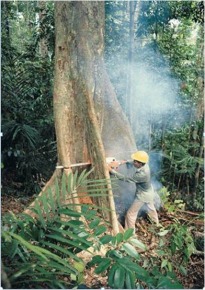What Triggers Mass Flowering of Dipterocarp Forests in Southeast Asia?

Trees of the Dipterocarpaceae family (commonly referred as dipterocarps) exhibit a unique flowering and fruiting pattern. Particularly, in aseasonal tropics of Southeast Asia they display community wide synchronized flowering and subsequent fruiting events, which occur irregularly every two to ten years (1). The seeds become not viable after only a few weeks of shedding. This leaves no seed bank in the soil for regeneration. Reforestation efforts have been largely unseccessfull because of it. Moreover, this type of forest is at a high risk of disappearing due to extensive logging for its valuable hardwood.
Dipterocarp forests dominate low to mid-elevation tropical forests in Southeast Asia and contribute as much as 80% of canopy biomass (1). Loss of this type of forest is already causing detrimental impacts such as loss of animal and plant biodiversity, soil and water erosion, and changes of the local climate. Conservation efforts of dipterocarp forest are difficult because the triggers of its reproduction are poorly understood (2). Several studies point to an existence of climatic triggers (1)(2)(3), but no significant correlation between any climate variables and flowering was established.
In this study, I analyzed 53 years of compiled phenological and weather data for three regions in Southeast Asia: Peninsular Malaysia, Borneo, and the Philippines. A preliminary analysis shows strong correlation between El Niño anomaly and flowering in dipterocarp forests in Borneo. This relationship weakens in Malaysia and the Philippines. In addition, El Niño correlates to lowered rainfall in all three regions, with the strongest correlation in Borneo. This suggests that drought and El Niño may be the trigger for synchronization of flowering. However, other mechanisms of flowering synchronization need to be examined. _____________________________________________________________________
(1) Curran, L. M., I. Caniago, G. D. Paoli, D. Astianti, M. Kusneti, M. Leighton, C. E. Nirarita, and H. Haeruman. 1999. Impact of El Niño and logging on canopy tree recruitment in Borneo. Science 286:2184-2188.
(2) Appanah, S. 1993. Mass Flowering of Dipterocarp Forests in the Aseasonal Tropics. Journal of Biosciences 18:457-474.
(3) Sakai, S., R. D. Harrison, K. Momose, K. Kuraji, H. Nagamasu, T. Yasunari, L. Chong, and T. Nakashizuka. 2006. Irregular droughts trigger mass flowering in aseasonal tropical forests in Asia. American Journal of Botany 93:1134-1139
Dipterocarp forests dominate low to mid-elevation tropical forests in Southeast Asia and contribute as much as 80% of canopy biomass (1). Loss of this type of forest is already causing detrimental impacts such as loss of animal and plant biodiversity, soil and water erosion, and changes of the local climate. Conservation efforts of dipterocarp forest are difficult because the triggers of its reproduction are poorly understood (2). Several studies point to an existence of climatic triggers (1)(2)(3), but no significant correlation between any climate variables and flowering was established.
In this study, I analyzed 53 years of compiled phenological and weather data for three regions in Southeast Asia: Peninsular Malaysia, Borneo, and the Philippines. A preliminary analysis shows strong correlation between El Niño anomaly and flowering in dipterocarp forests in Borneo. This relationship weakens in Malaysia and the Philippines. In addition, El Niño correlates to lowered rainfall in all three regions, with the strongest correlation in Borneo. This suggests that drought and El Niño may be the trigger for synchronization of flowering. However, other mechanisms of flowering synchronization need to be examined. _____________________________________________________________________
(1) Curran, L. M., I. Caniago, G. D. Paoli, D. Astianti, M. Kusneti, M. Leighton, C. E. Nirarita, and H. Haeruman. 1999. Impact of El Niño and logging on canopy tree recruitment in Borneo. Science 286:2184-2188.
(2) Appanah, S. 1993. Mass Flowering of Dipterocarp Forests in the Aseasonal Tropics. Journal of Biosciences 18:457-474.
(3) Sakai, S., R. D. Harrison, K. Momose, K. Kuraji, H. Nagamasu, T. Yasunari, L. Chong, and T. Nakashizuka. 2006. Irregular droughts trigger mass flowering in aseasonal tropical forests in Asia. American Journal of Botany 93:1134-1139

